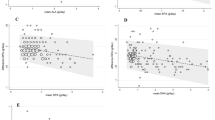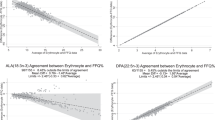Abstract
Long-chain omega-3 PUFA (LC n−3 PUFA) are beneficial for health. To date there is no specific food frequency questionnaire (FFQ) to assess LC n−3 PUFA intakes. The objective of this study is to validate our newly developed FFQ by comparison with LC n−3 PUFA content of both red blood cells (RBC) and plasma, expressed as a percentage of total FA. Fifty-three healthy male and female subjects were recruited from Wollongong, Australia. Average LC n−3 PUFA intakes (mg/d) were estimated using the new FFQ. RBC and plasma FA were assessed using GC. Spearman correlation coefficients were used to assess the linear relationship between FFQ intakes and both RBC and plasma FA. The results show that there were significant Spearman's correlation coefficients between the FFQ intakes and RBC (and plasma) FA for total LC n−3 PUFA, EPA, and DHA (0.50 (0.54), 0.39 (0.54) and 0.40 (0.48), respectively) but not for docosapentaenoic acid. The FFQ was also an effective ranking tool. The FFQ is a valid method based on erythrocyte and plasma FA as biochemical markers. In conclusion, the new FFQ is a valid method that can be used to estimate the LC n−3 PUFA intake of adults.
Similar content being viewed by others
Abbreviations
- FFQ:
-
food frequency questionnaire
- FR:
-
food record
- ISSFAL:
-
International Society for the Study of Fatty Acids and Lipids
- LC n−3 PUFA:
-
long-chain n−3 PUFA
- NNS:
-
National Nutrition Survey
- RBC:
-
red blood cells
References
GISSI-Prevenzione Investigators. (1999) Dietary Supplementation with N−3 Polyunsaturated Fatty Acids and Vitamin E After Myocardial Infarction: Results of the GISSI-Prevenzione Trial, Lancet 354, 447–455.
von Schacky, C., Angerer, P., Kothny, W., Theisen, K., and Mudra, H. (1999) The Effect of Dietary Omega-3 Fatty Acids on Coronary Atherosclerosis—A Randomized, Double-Blind, Placebo-Controlled Trial, Ann. Int. Med., 130, 554–562.
de Lorgeril, M., Salen, P., Martin, J.L., Monjaud, I., Delaye, J., and Mamelle, N. (1999) Mediterranean Diet, Traditional Risk Factors, and the Rate of Cardiovascular Complications After Myocardial Infarction—Final Report of the Lyon Diet Heart Study, Circulation 99, 779–785.
Siscovick, D.S., Raghunathan, T.E., King, I., Weinmann, S., Wicklund, K.G., Albright, J., Bovbjerg, V., Arbogast, P., Smith, H., Kushi, L.H., et al. (1995) Dietary-Intake and Cell-Membrane Levels of Long-Chain N−3 Polyunsaturated Fatty-Acids and the Risk of Primary Cardiac-Arrest, JAMA 274, 1363–1367.
Connor, W.E. (2000) Importance of n−3 Fatty Acids in Health and Disease, Am. J. Clin. Nutr. 71, 171S-175S.
Simopoulos, A.P. (1999) Essential Fatty Acids in Health and Chronic Disease, Am. J. Clin. Nutr. 70, 560S-569S.
Ollis, T.E., Meyer, B.J., and Howe, P.R.C. (1999) Australian Food Sources and Intakes of Omega-6 and Omega-3 Polyunsaturated Fatty Acids, Ann. Nutr. Metab. 43, 346–355.
Meyer, B.J., Mann, N.J., Lewis, J.L., Milligan, G.C., Sinclair, A.J., and Howe, P.R.C. (2003) Dietary Intakes and Food Sources of Omega-6 and Omega-3 Polyunsaturated Fatty Acids, Lipids 38, 391–398.
Kris-Etherton, P.M., Harris, W.S., and Appel, L.J. American Heart Association Nutrition Committee. (2002) Fish Consumtion, Fish Oil, Omega-3 Fatty Acids, and Cardiovascular Disease, Circulation 106, 2747–2757 [published correction appears in Circulation 107, 512].
International Society for the Study of Fatty Acids and Lipids (ISSFAL) (2004) http://www. issfal.org.uk/welcome/PolicyStatement3.asp (accessed March 2006).
Sugano, M. (1996) Characteristics of Fats in Japanese Diets and Current Recommendations, Lipids 31, S283-S286.
Sullivan, B.L., Brown, J., Williams, P.G., and Meyer, B.J. (2006) Dietary Validation of a New Food Frequency Questionnaire That Estimates Long Chain Omega-3 Polyunsaturated Fatty Acids. Eur. J. Clin. Nutr. (submitted manuscript).
Arab, L. (2003) Biomarkers of Fat and Fatty Acid Intake, J. Nutr. 133, 925S-932S.
Bates, C.J., Thurman, D.I., Bingham, S.A., Margetts, B.M., and Nelson, M. (1997) Biochemical Markers of Nutrient Intake. In: Design Concepts in Nutritional Epidemiology, Margetts, B.M., and Nelson, M., eds., pp. 170–241, Oxford University Press, Oxford.
Connor, S.L., Zhu, N., Anderson, G.J., Hamill, D., Jaffe, E., Carlson, J., and Conor, W.E. (2000) Cheek Cell Phospholipids in Human Infants: a Marker of Docosahexaenoic and Arachidonic Acids in the Diet, Plasma, and Red Blood Cells, Am. J. Clin. Nutr. 71, 21–27.
Potischman, N. (2003) Biologic and Methodologic Issues for Nutritional Biomarkers, J. Nutr. 133, 875S-880S.
Roberts, D.C.K., and Byleveld, P.M. (1992) Biological Markers for n−3 Fatty Acid Intake—Dose Response and Persistence of Change in Red Cell Membrane Fatty Acids After Fish Oil Feeding. In Essential Fatty Acids and Eicosanoids, Sinclair A, and Gibson R, eds., Invited Papers from the Third International Congress of the American Oil Chemists Society, pp. 71–80, American Oil Chemists' Society, Champaign, IL.
Andersen, L.F., Solvoll, K., and Drevon, C.A. (1996) Very-Long-Chain n−3 Fatty Acids as Biomarkers for Intake of Fish and n−3 Fatty Acids Concentrates, Am. J. Clin. Nutr. 64, 305–311.
Bjerve, K.S., Brubakk, A.M., Fougner, K.J., Johnsen, H., Midthjell, K., and Vik, T. (1993) Omega-3-Fatty-Acids—Essential Fatty Acids with Important Biological Effects, and Serum Phospholipid Fatty-Acids as Markers of Dietary Omega-3-Fatty-Acid Intake, Am. J. Clin. Nutr. 57, S801-S806.
Howe, P.R.C., Meyer, B.J., Record, S., and Baghurst, K. (2006) Dietary Intake of Long-Chain ω-3 Polyunsaturated Fatty Acids: Contribution of Meat Sources, Nutrition 22, 47–53.
McLennan, W., and Podger, A. (1999) National Nutrition Survey, Foods Eaten, Australia, Australian Government Publishing Service, Canberra.
Ridges, L., Sunderland, R., Moerman, K., Meyer, B., Howe, P. (2001) Cholesterol Lowering Benefits of Soy and Linseed Enriched Foods, Asia Pacific J. Clin. Nutr. 10(3), 204–211.
Lepage, G., and Roy, C.C. (1986) Direct Transesterification of All Classes of Lipids in a One-Step Reaction, J. Lipid Res. 27, 114–120.
Meyer, B.J., Tsivis, E., Howe, P.R.C., Tapsell, L., and Calvert, G.D. (1999) Polyunsaturated Fatty Acids Content of Foods: Differentiating Between Long and Short Chain Omega-3 Fatty Acids, Food Australia 51, 81–95.
Woods, R.K., Stoney, R.M., Ireland, P.D., Bailey, M.J., Raven, J.M., Thien, F.C., Walters, E.H., and Abramson, M.J. (2002) A Valid Food Frequency Questionnaire for Measuring Dietary Fish Intake, Asia Pacific J. Clin. Nutr. 11, 56–61.
Mann, N.J., Sinclair, A.J., Percival, P., Lewis, J.L., Meyer, B.J., and Howe, P.R.C. (2003) Development of a Database of Fatty Acids of Australian Foods, Nutr. Diet 60(1), 34–37.
Katan, M.B., Deslypere, J.P., van Birgelen, A., Penders, M., and Zegwaard, M. (1997) Kinetics of the Incorporation of Dietary Fatty Acids into Serum Cholesteryl Esters, Erythrocyte Membranes, and Adipose Tissue: An 18-Month Controlled Study, J. Lipid Res. 38, 2012–2022.
Agren, J.J., Tormala, M.L., Nenonen, M.T., and Hanninen, O.O. (1995) Fatty Acid Composition of Erythrocyte, Platelet, and Serum Lipids in Strict Vegans, Lipids 30, 365–369.
Erkkola, M., Karppinen, M., Javanainen, J., Rasanen, L., Knip, M., and Virtanen, S.M. (2001) Validity and Reproducibility of a Food Frequency Questionnaire for Pregnant Finnish Women, Am. J. Epidemiol. 154, 466–476.
Author information
Authors and Affiliations
Corresponding author
About this article
Cite this article
Sullivan, B.L., Williams, P.G. & Meyer, B.J. Biomarker validation of a long-chain omega-3 polyunsaturated fatty acid food frequency questionnaire. Lipids 41, 845–850 (2006). https://doi.org/10.1007/s11745-006-5039-0
Received:
Accepted:
Issue Date:
DOI: https://doi.org/10.1007/s11745-006-5039-0




